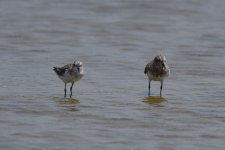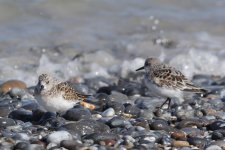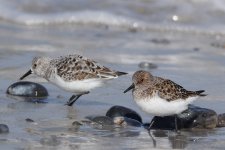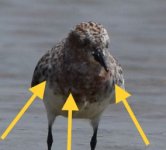-
Welcome to BirdForum, the internet's largest birding community with thousands of members from all over the world. The forums are dedicated to wild birds, birding, binoculars and equipment and all that goes with it.
Please register for an account to take part in the discussions in the forum, post your pictures in the gallery and more.
You are using an out of date browser. It may not display this or other websites correctly.
You should upgrade or use an alternative browser.
You should upgrade or use an alternative browser.
Little Stint?(L) (1 Viewer)
- Thread starter Boat_Andaman
- Start date
More options
Who Replied?Andy Adcock
Worst person on Birdforum

Little Stint would be a rarity I think, these should be Red-necked.
A
A
rockfowl
Mark Andrews
Little Stint would be a rarity I think, these should be Red-necked.
A
What both of them?
johnallcock
Well-known member
They both look like Red-necked to me.
Deb Burhinus
Used to be well known! 😎

Sanderling on the right imo - bulkier/longer legged than stint (s) with apparently longer bill in photo and clear mottled grey/rufous breast band extending to sides of breast with no apparent streaking.
Last edited:
Rotherbirder
Well-known member

johnallcock
Well-known member
I can see the argument for a Sanderling, but I still think the bird on the right looks more like a Red-necked in moult into breeding plumage. To me it looks similar in size to the stint on the left. The bill looks fine-tipped and slightly decurved, unlike the straight and thicker bill of a Sanderling. The breast pattern also seems slightly more like a moulting stint - some solid brick-red feathers emerging among greyer feathers and with a white chin, not the dark-tipped chestnut feathers of Sanderling.
It would be useful to see photos from another angle if they are available.
It would be useful to see photos from another angle if they are available.
Tib78
Well-known member
Is a Sanderling!
RB
That’s some very intense red feathers starting to appear on the breast for a Sanderling. Likewise, the black streaks on a white background as showing right down the center of the chest would be weird on a sanderling. I agree with John (edit: who just beat me to it).
CARERY
Well-known member
I can see the argument for a Sanderling, but I still think the bird on the right looks more like a Red-necked in moult into breeding plumage. To me it looks similar in size to the stint on the left. The bill looks fine-tipped and slightly decurved, unlike the straight and thicker bill of a Sanderling. The breast pattern also seems slightly more like a moulting stint - some solid brick-red feathers emerging among greyer feathers and with a white chin, not the dark-tipped chestnut feathers of Sanderling.
It would be useful to see photos from another angle if they are available.
The seemingly rather fine-tipped bill is the main reason why I wrote 'should be Sanderling'. I agree the difference in size to the Stint should be more obvious... hmmm
Any more pics?
Tib78
Well-known member
The seemingly rather fine-tipped bill is the main reason why I wrote 'should be Sanderling'. I agree the difference in size to the Stint should be more obvious... hmmm
Any more pics?
Really, it’s not a sanderling. Apart from size and breast pattern/colour , note also the coarse black spotting to the crown, this should not happen on sanderling acquiring fresh breeding plumage.
CARERY
Well-known member
I'm not sure that I know what you mean by coarse black spotting to the crown... Very recently photographed the attached Sanderlings on Heligoland and I find the crown looks rather similar to the OP, no? Also breast pattern... Generally I find the OP picture quite tricky also because of the backlight. I'm not saying the right OP has to be a Sanderling only that I'm not competely convinced yet it is a RNS.
Attachments
Tib78
Well-known member
I'm not sure that I know what you mean by coarse black spotting to the crown... Very recently photographed the attached Sanderlings on Heligoland and I find the crown looks rather similar to the OP, no? Also breast pattern... Generally I find the OP picture quite tricky also because of the backlight. I'm not saying the right OP has to be a Sanderling only that I'm not competely convinced yet it is a RNS.
I must admit your sanderling does show coarse crown streaking, good one!
However my point still stands, somehow. Let me clarify a bit: even bearing in mind the counter example you provided, the head streaking on a sanderling is usually finer and more uniformly disposed on the head compared to the subject bird. In RNS the head streaking may be finer or coarser but is more or less confined to the crown, while the ear-coverts are uniformely reddish. The result is that the head pattern is globaly more uniform in sanderling than in RNS.
But anyway, I am not sure we need to get into that level of details considering that the breast pattern and colour should readily point towards RNS. And to add another point: the amount of tibia visible is not the norm for a resting sanderling.
CARERY
Well-known member
The result is that the head pattern is globaly more uniform in sanderling than in RNS.
But anyway, I am not sure we need to get into that level of details considering that the breast pattern and colour should readily point towards RNS. And to add another point: the amount of tibia visible is not the norm for a resting sanderling.
I find the head pattern quite uniform - uniformly patterned. The light is not the best to be sure about the real pattern and colour. As for the breast the sharp border to the white belly for me looks somehow better for Sanderling. The long tibia might not be the norm for Sanderling but the feathers really look pressed to the body (probably not the right term to use but I hope you know what I mean) resulting in longer legs and slimmer shape. To me so far only the seemingly small size is disturbing. That's why I was hoping for more pics.... still not convinced it is a RNS.
Tib78
Well-known member
Ok one last try: note the feathers highlighted by the arrows. They are pale geyish/withish with a contrasting and round black dot. If this is a sanderling, then to what plumage type do these feathers relate to? Breeding? Non-breeding? Juvenile?
And if you think those feathers do fit sanderling in any plumage, please provide a link showing such a bird.
Here is a spring RNS showing the same pattern to the breast : http://orientalbirdimages.org/search.php?Bird_Image_ID=153547&Bird_ID=1241&Bird_Family_ID=&Location=
And if you think those feathers do fit sanderling in any plumage, please provide a link showing such a bird.
Here is a spring RNS showing the same pattern to the breast : http://orientalbirdimages.org/search.php?Bird_Image_ID=153547&Bird_ID=1241&Bird_Family_ID=&Location=
Attachments
CARERY
Well-known member
I'm unworthy of your patience, Tib 8-P
The point I was trying to make is that I find this backlit picture quite tricky to be sure about some features you mentioned. Therefore my request for more photos - as also John did BTW...
However, the feathers you highlighted do indeed look better for RNS. I failed to dig up a picture of a Sanderling showing feathers with exactly the same pattern. Nevertheless I attached a late July Sanderling in similar lighting with quite some streaks on it's breast on rather pale feathers:
http://birdphoto.fi/lajikuvat/kuvahtml/3calalb392.html
The point I was trying to make is that I find this backlit picture quite tricky to be sure about some features you mentioned. Therefore my request for more photos - as also John did BTW...
However, the feathers you highlighted do indeed look better for RNS. I failed to dig up a picture of a Sanderling showing feathers with exactly the same pattern. Nevertheless I attached a late July Sanderling in similar lighting with quite some streaks on it's breast on rather pale feathers:
http://birdphoto.fi/lajikuvat/kuvahtml/3calalb392.html
rockfowl
Mark Andrews
The right hand bird is a Red-necked Stint. Whilst the left hand bird does look longer-legged above the knee (supportive of a Little Stint) it’s impossible to see much else from this single shot so we should assume it’s a Red-necked Stint.
Those were my initial thoughts too.
Users who are viewing this thread
Total: 2 (members: 0, guests: 2)







